Economical heating pellets: is it worth switching to a solid fuel system?
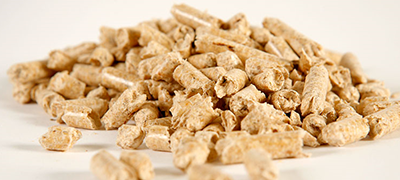
Pellets are pressed granules. They are supplied in bags or in bulk. The shape of the pellet can be different, depending on the specific manufacturer. The composition of the granules may also differ depending on the materials they contain.
Content
Pellets: what are they?
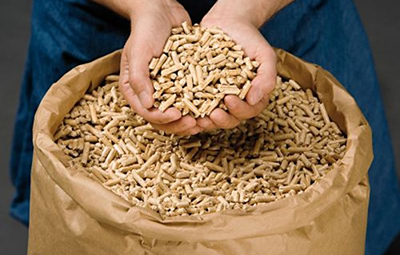
Typically, a fuel unit has the following parameters:
- Length – from 0.5 to 5 cm.
- Diameter – from 6 to 8 mm.
These granules are processed product various wood processing waste.
This could be sawdust, bark, all kinds of trimmings, shavings or chips.
Types of pellet heating systems and composition of granules
Heating with pellets solid fuel has many advantages, but there is one circumstance that can be called a significant disadvantage - this is need for constant monitoring from the human side. He must add fuel, clean the firebox, and also adjust the dampers on the chimney.
But recently, heating boilers using pellets have become especially popular, which differ in one important point - this is the ability to work for a long time without human interventionThis is a special type of fuel, which is a compressed mass consisting of crushed combustible waste.
The following components can be used as additional materials in pellets:
- Peat.
- Husk.
- Dried manure.
- Straw.
- Oil cake, etc.
This practice of using pellets allows you to solve the problem immediately two problems – this is the disposal of waste from wood processing production, as well as the production of fairly economical fuel in the form of pellets.
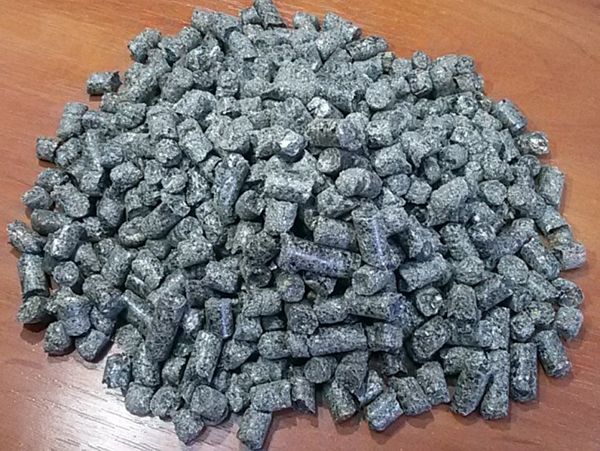
Photo 1. Heating pellets, which include sunflower husk as an additional material.
In addition, pellets are made from recycled wood. Chipboard, MDF, plywood – all this can be the basis for this “solid biofuel”. However, application these granules quite limited, which is explained by the high content of binders in the composition.
Important! Color and consistency The granule content varies depending on the specific material used as the base.
Types pellets
There are several types of granules:
- Industrial. The granules have a grey-brown tint. Ash content – more than 0.7%. This indicator indicates that the granules contain high bark content. This material is quite affordable, but such savings can lead to certain problems. The fact is that some household boilers are not designed to work with pellets, which leads to breakdowns. In addition, the use of industrial granules leads to frequent cleaning of the boiler from ash.
- Agropellets. This material is also characterized by high ash content. That is why such fuel is most often used in large thermal power plants, and not in ordinary domestic boilers. Another disadvantage is low strength granules, so some of them simply crumble during transportation.
- White pellets. This material is considered the highest quality of all those present. The granules can be white or have small gray or yellow inclusions. In addition to the pleasant smell of real wood, white pellets are characterized by a low ash content – 0.5%. Cleaning boiler required once every two months, which is good not only for the user, but also for the equipment, because it practically does not wear out.
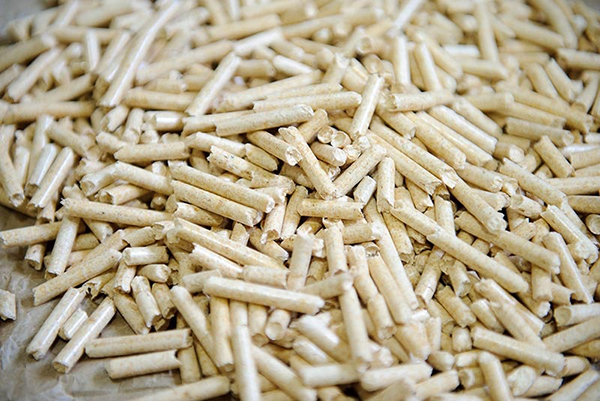
Photo 2. White pellet granules with a low ash content emit a pleasant wood smell.
Which Are pellets better for a stove?
Pellet boilers are quite reliable in their operation, but they can also fail. As a rule, the reason for this is poor quality solid fuel, so you need to know the main points to pay attention to when choosing pellets for the stove.
There are no standards in Russia the quality of this material, therefore it is necessary rely on information from Western manufacturers of such fuel. They adhere to fairly strict rules for pellet production, storage and transportation, so their experience will be very useful.
The most important characteristics of pellets are not only the length and diameter, but also the following parameters:
- Ash content.
- Nominal humidity.
- Specific thermal performance.
- Density.
- Percentage content of harmful impurities and metals.
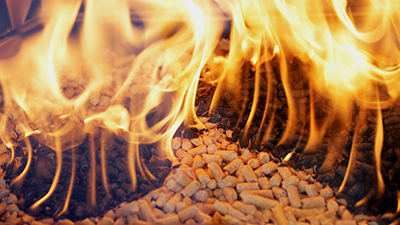
The best pellets are those that are made from primary wood.
They produce more thermal energy, which is the main criterion of quality. In addition, they are practically free of harmful impurities.
The color of the granules can be quite deceptive. Dark shade may indicate that the fuel contains a large amount of bark, which does not ignite very well. At the same time, the dark color may indicate that they slightly burnt during production, but this does not affect their quality characteristics in any way.
Reference! Indicator humidity should not exceed 10%. In addition, you need to check the granules for strength - if they easily crumble in your hands, this will indicate low quality of pellets. Percentage content dust in granules should not be more than 2.3.
Calculation of material consumption for a private house: how many tons are needed for the winter
As an example for calculating the amount of fuel, let's take a private house, the area of which is 100 square meters.
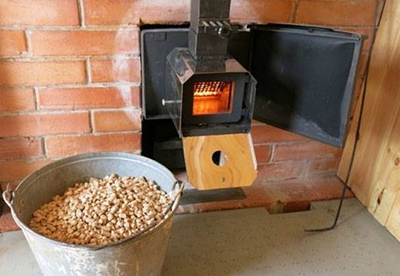
It is necessary to know the boiler power. If there is no exact figure, then for the calculation we will take the average indicator - 10 kWHow many tons of pellets are needed for the winter?
As a rule, the heating season in Russia consists of from 7 months. The calculation is as follows: 10 kW * 30 (days in a month) * 24 (hours) * 7 (months) = 50,400 kW per hour.
It is clear that the boiler does not work with round knocks, so we will introduce an equalizing coefficient - 0.7. So: 50,400 * 0.7 = 35,300 kW per hour.
It is known that 1 kg pellet equivalent 3.5 kW per hour. It turns out: 35,300/3.5 = 10 tons for 7 months, or 1.5 tons of fuel for one month.
How does a boiler work?
The standard pellet boiler is installed on the floor. It includes the following elements:
- The case inside which all the main devices are located. In addition, it may include a tank, fan and circulation pump.
- Pellet burner. It resembles a regular metal tray with holes in the bottom. There is a blower fan next to the burner, and heating elements are used as ignition means.
- Combustion chamber. It is significantly smaller than the chamber in a conventional boiler, which is explained by the metered supply of granules.
- Heat exchanger – a hollow structure made of cast iron or steel.
- Fuel bunker. Granules are poured into the tank. It is better to choose a more voluminous option, which will allow achieving a certain autonomy of operation.
- A screw conveyor that feeds pellets into the burner.
- Electronic controller, which records information from sensors and also allows the unit to be controlled remotely.
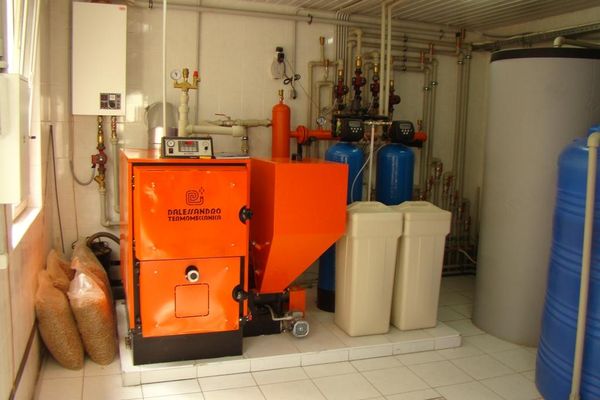
Photo 3. A standard boiler with a pellet heating system is installed on a tiled floor in a room.
Pros and cons
Pellet boilers are a cost-effective solution if there is no possibility of connecting to the gas main network. Its main advantages are as follows:
- Partial autonomy of work, which allows a person not to participate in the process for several days.
- Easy to operate. Planned cleaning is carried out in total once a month.
- Efficiency 95%.
- Economy, if you compare pellets with electricity or gas.
- The service life reaches 20 years.
There are also a number disadvantages:
- The cost of pellets can vary significantly., depending on the region.
- Boilers are vulnerable to poor quality fuel.
- The need for special place for storing granules.
- The unit has quite large sizes.
Production DIY pellets: what they are made of and how
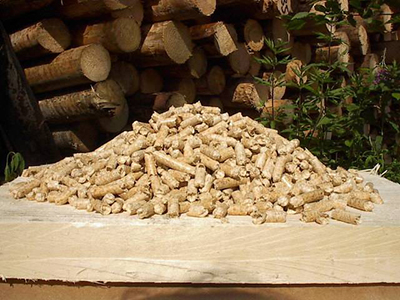
The entire process of making fuel with your own hands can be divided into several stages:
- Processing of raw materials by crushing. There are household crushers on sale, which produce chips of small thickness and size.
- Next, the chips need to be thoroughly dried. A regular tumble dryer can be used for this purpose. Make sure that humidity was not less than 8%, otherwise you will have to moisten the pellets.
- Pressing with a granulator. The temperature in its chamber is quite high, which allows the formation of granules.
- The final stage is cooling. The granules are scattered on a flat surface, after which they cool to normal temperature.
Important! Crushing is not done if the basis of the pellets is sawdust.
To produce pellets yourself, you will need: certain equipment - dryer, crusher and granulator. They can be purchased or made independently based on drawings from the Internet.
Useful video
In the video you can see how quickly pellets burn in a small boiler.
Conclusion
An important point is the issue of pellet storage. Bags of fuel are placed in a dry, well-ventilated room with a wooden floorIt is important to ensure that the bags do not get wet, otherwise the granules will soften and, as a result, will be destroyed.







Comments
They can be used where combustion does not require the release of a particularly large amount of heat. For example, when it is necessary to maintain the temperature of an already heated stove.
But time does not stand still and probably soon cheap technologies will be developed that increase their heat output, so pellets have a great future.